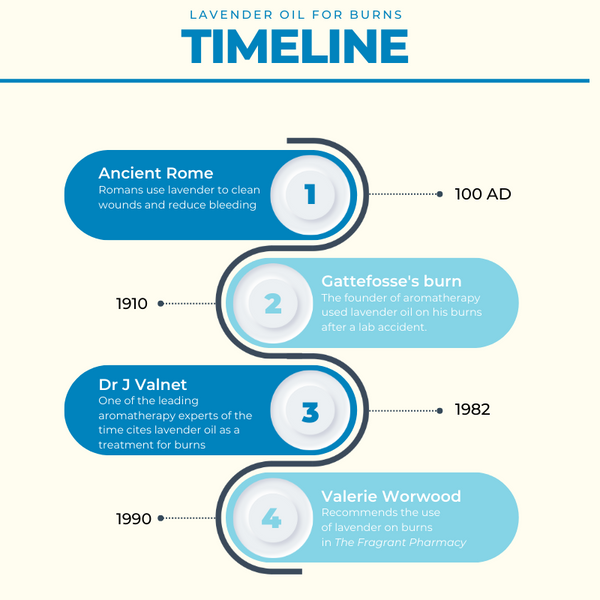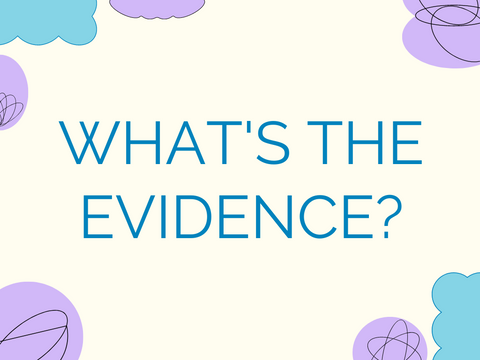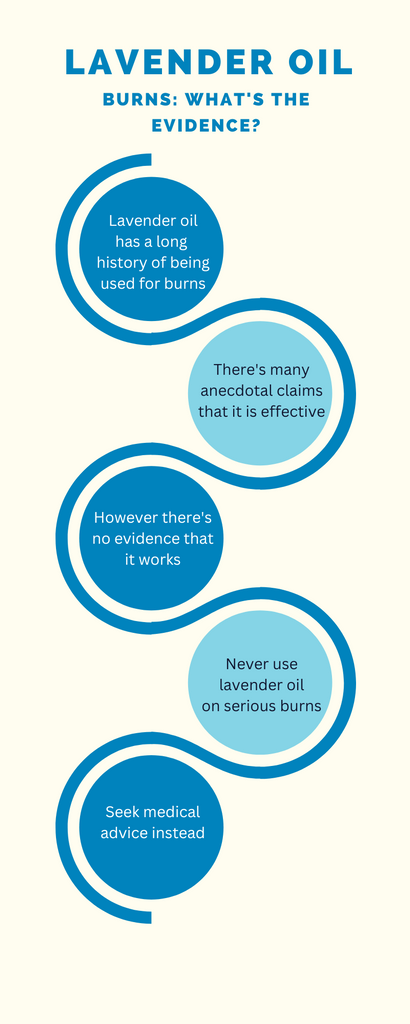In 1990, Valerie Worwood wrote in her famous book, The Fragrant Pharmacy, ‘‘every home should have a bottle of lavender…because it is so very effective in the treatment of burns and scalds’’.
She wasn’t the first, and certainly not the last, person to claim the benefits of lavender essential oil for healing burns either. But at The Soapery, we prefer to take anecdotal evidence with a pinch of salt. We believe in looking at traditional remedies with the hindsight of modern knowledge.
In this post, we’ll cover all the things you should consider before you decide to try lavender essential oil on your burns. If, equipped with the truth, you do decide to use it for burn relief, follow our guide on how to do so safely.
Contents
- A brief history of lavender oil for burns
- Are there studies to support lavender oil for burns?
- When can you use lavender oil for burns?
- How to use lavender oil for burns
- Conclusion: does lavender oil help burns?

A brief history of lavender oil for burns
Lavender essential oil is distilled from the flowers of the lavender plant, Lavandula Angustifolia, and is perhaps one of the most popular aromatherapy oils. You’re likely familiar with its soothing scent, which is best-known in aromatherapy for sleep-inducing and anxiety-busting qualities.
But are there healing benefits beyond the aroma? Is it, as Worwood claims, an effective treatment of burns and scalds?
A brief look back in time will give us a clearer idea of whether we all really should have a bottle of lavender oil to hand.
Lavender essential oil in ancient times
Like most natural remedies, the medicinal use of lavender goes back to ancient civilisations.
According to the Handbook of 200 Medicinal Plants, Romans knew the herb as ‘Romero Santa’, or sacred rosemary, and used it to reduce bleeding and cleanse wounds. Persian polymath Avicenna mentioned it as an effective treatment for epilepsy, mania, melancholy, and amnesia. It was also used in Turkish traditional medicine to treat infections.
Although it was used for centuries to promote healing, reference to burns specifically comes much later on.
Gattefosse’s burn
Lavender oil gained a name as a burn treatment in 1910, when Rene Gattefosse, the ‘founder of aromatherapy’, had a painful accident in his laboratory, which he chronicled in his book Aromatherapie.
The basic story, as you’ll find it on many websites and sources, follows:
After an explosion left him with burns on his hands, Gattefosse rinsed them in lavender essential oil. He noted that the wounds healed more rapidly than usual and without any scarring.
This is said to have inspired him to investigate the healing power of essential oils and take this knowledge to soldiers in the military hospitals during the First World War.
So, did he discover an effective treatment for burns?

How true is the tale?
It’s a good story, which explains why it’s referenced a lot, but some key details are often left out.
In Gattefosse’s own description of what happened, translated from French, the connection isn’t so clear-cut:
The external application of small quantities of essences rapidly stops the spread of gangrenous sores. In my personal experience, after a laboratory explosion covered me with burning substances which I extinguished by rolling on a grassy lawn, both my hands were covered with a rapidly developing gas gangrene. Just one rinse with lavender essence stopped ‘‘the gasification of the tissue’’. This treatment was followed by profuse sweating, and the healing process began the next day.
Note, he didn’t immediately dunk the wounds in lavender essential oil, and he didn’t miraculously recover right after.
The wounds became infected (hence the sweating) and he rinsed them in a small amount of lavender essential oil, which may have had a cleansing effect. If anything, the tale is more a suggestion of lavender’s antimicrobial effect than evidence of its burn-healing potential.
While we don’t want to rain on Gattefosse’s parade, especially if the incident did inspire his subsequent work, the story isn’t the proof we need.
A household remedy
In Dr. J Valnet’s The Practice of Aromatherapy in 1982, he shares a similar tale to Gattefosse.
A woman had the misfortune to upset a saucepan of boiling water over her left forearm and hand. A nurse dressed the lesions with a mixture of aromatic essences which had long seemed to me the ideal treatment for burns, its chief constituents being lavender, thyme, geranium, rosemary and sage.
Fifteen hours after the accident, her hand and forearm were no longer a problem at all; the skin was unmarked.
He then goes on to share a story about an overzealous colleague, who was definitely very dedicated to the study of essential oils!
A colleague of mine once went ahead and deliberately burned two fingers of his left hand. He immediately treated one finger with the mixture of aromatic essences. The other finger he left alone. In a matter of minutes, there was no pain in the treated finger, and the next day not even a sign of the burn.
He’s referring to the blend of essential oils from the first quote here. He also goes on to list lavender essential oil specifically as a treatment for burns.
This brings us to 1990 when Valerie Worwood told us we should all have a bottle in our medicine cabinet in case of burns.

Are there studies to support lavender oil for burns?
Anecdotes need to be backed by reliable studies before we can say anything for sure. And, unfortunately, there’s no scientific evidence here.
Some studies are commonly referenced to try and support the claim that lavender essential oil can help heal burns. A popular one is this study which suggests essential oil can help care for episiotomy wounds. Another one looks at lavender oil in accelerating aspects of wound healing.
Yet, neither investigates healing burnt skin. The latter doesn’t even look at human skin at all, as it was done on rats.
It's irresponsible to take studies about the wound healing process and use them to suggest that lavender essential oil can help treat minor burns.
If the anecdotal evidence is still enough to make you want to try it, then you’re welcome to go ahead, just make sure you do so safely.
When can you use lavender essential oil for burns?
Despite what the stories suggest, you should not go straight for an oil of any kind when you’ve been burnt.
Firstly, essential oils should never be applied directly to the skin. They should be diluted or mixed with a carrier oil. This is especially important when it comes to vulnerable damaged skin like a burn.
Secondly, because applying greasy substances, like coconut oil, olive oil, and other carrier oils, can hold heat in and may cause the skin to continue to burn.
The NHS describes superficial epidermal burns as where ‘‘your skin will be red, slightly swollen and painful, but not blistered’’. Also known as first degree burns.
We don’t recommend essential oils on anything more than this– for severe burns, seek medical attention immediately.
So, when can you use lavender essential oil? To put it simply,
- After taking immediate action (as described below!)
- On minor burns or sunburn
- When the oil is diluted or mixed with a carrier oil

How to use lavender oil for minor burn relief
Here’s a step-by-step guide to safely treating minor burns with lavender oil, if you want to try the home remedy for yourself:
1: Take immediate action
The NHS advice is that when you first get a burn, you should
- Immediately get away from the heat source
- Remove clothing and jewellery that’s near the burnt area
- Cool the burn in lukewarm running water for 20-30 minutes
- Do not use ice, ice water, creams, or any greasy substances (so no oils yet!)
2: Cover the wound
After cooling the burn, cover it with a layer of cling film.
3: Dilute and apply the oil
When the burn starts to heal, you could mix 2ml of lavender essential oil in 100ml of a carrier oil, and apply it as an ointment.
Or you could try mixing 2ml of lavender essential oil into 100g of aloe vera gel, and applying that to the burn
4: Is there any irritation?
If there’s any irritation at all, or the burn seems to be getting worse than better, stop using the oil straight away.
It might be an allergic reaction or an indicator that your burn is more serious than you thought. If that’s the case, seek medical attention.

Conclusion: Does lavender oil help burns?
Lavender oil has a long history of being used to treat burns, which has meant it’s crept into texts on how to heal burns naturally.
That said, there isn’t any scientific evidence that it works.
We recommend sticking to the lavender essential oil for a calming room spray or soothing soap. If you do decide to give it a go for treating burns, make sure you’re careful and follow medical advice.
Definitely don't use essential oils on second or third degree burns.
Even if lavender oil doesn’t make it better, let’s try not to make it worse!
Continue reading
Now that you've learned about essential oils for burns, why not continue learning?
- Interested in the evidence behind peppermint oil and hair growth? Read more
- Can essential oils help boost your mood? Find out more!
- Want to know more about using essential oils? Read more about the best carrier oils for essential oils
Have you tried using essential oils for burns? Comment below and let us know.



